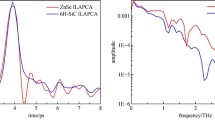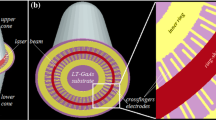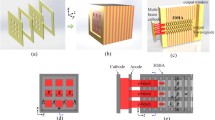Abstract
A technique of enhancing and broadening terahertz (THz) wave radiation from large aperture photoconductive (PC) antenna is presented in this paper. In this technique, the PC antenna is excited by both the optical and previously generated THz pulses by a laser-induced air plasma created in front of PC antenna and an enhanced and broadened THz wave signal is obtained. The theoretical and experimental investigation shows that the superposition is the main mechanism for this enhancement. The technique shown in this paper can be very useful for THz imaging and spectroscopy.
Similar content being viewed by others
Avoid common mistakes on your manuscript.
Among different types of THz sources, such as nonlinear crystal-based nonlinear optical rectification [1], nanostructured surface plasmon excitation [2, 3], or recently developed THz quantum cascade lasers [4], PC antenna-based THz source has the advantage of being easy to operate and implement. However, optical pump saturation effect on PC antenna always acts as a critical restriction on generating more powerful THz radiation. Another issue associated with the semi-insulating (SI) GaAs-based PC antenna is its long carrier lifetime (~1 ns) [5], which limits the bandwidth of THz radiation to some extent. The emitted THz bandwidth normally does not extend beyond 2 THz and the central frequency is <1 THz if using a typical femtosecond pump source with a pulse duration of 100 fs or longer [6]. Although some papers reported broadband THz radiation from PC antenna, they relied mainly on the fast rising edge of carriers injected by extremely ultrashort pulses of pump beam (~15 fs) [7, 8], which was not easily accessible and expensive. On the other hand, the THz wave radiation generated by femtosecond laser-induced air plasma can have a broader bandwidth. However, the efficiency of THz wave generation is also low. In addition, a considerable portion of pump femtosecond laser energy (e.g., >50 %) was not utilized.
To improve the efficiency and bandwidth of THz wave generated by a PC antenna and recycle the unused portion of femtosecond laser energy employed for the air plasma generation, in this paper, we report an enhanced broadband THz emission from a strip line large aperture PC antenna by exciting it with both a femtosecond laser pump source (unused portion employed for air plasma generation) and an air plasma-generated THz wave. With the same input pump power and energy from the femtosecond laser, the overall efficiency and bandwidth of generated THz wave is higher than that of using a PC antenna or an air plasma alone. Furthermore, the physical mechanism of enhancement effect using both the PC antenna and the air plasma-generated THz wave excitation is also theoretically and experimentally investigated. The theoretical analyses agree well with the experimental results, which confirm that the superposition is the main mechanism for the effect of power enhancement and bandwidth broadening.
In our system, the femtosecond optical pump energy is divided into two parts: one part is used to create air plasma and generate THz wave and the remaining portion is to pump the PC antenna to emit the second THz signal, both of which are then constructively superposed with each other to generate the enhanced broadband THz radiation. It is well known that THz generation by laser-induced air plasma is a well-established technique, but its low conversion efficiency (only a few percent or less) wastes most of the pump energy even by employing double wavelength technology (i.e., plasma is generated by a superposition of fundamental and second-harmonic optical fields). However, our system could effectively increase the conversion efficiency by placing a PC antenna behind air plasma which could recycle the remaining pump energy and thus contribute to the final THz enhancement. And at the meantime, the saturation or breakdown issues associated with PC antenna when applying high pump optical energy could also be alleviated due to the relatively weak remaining optical pump energy for photoexcitation. Furthermore, the achievable bandwidth of THz radiation from the conventional PC antenna is limited not only by the input optical pulse duration but also by the carrier dynamics, especially for the SI-GaAs that usually has a slow carrier lifetime. On the other hand, the photo-induced air plasma-based THz generation is a good candidate for broadband THz source due to its highly nonlinear nature, which could be effectively combined with the unused portion of femtosecond laser radiation to enhance the power and bandwidth of the THz radiation from the SI-GaAs PC antenna.
To validate our proposed THz wave enhancement technique, we conducted following experiments. The experimental setup is shown in Fig. 1. An ultrafast optical beam from a regeneratively amplified Ti: sapphire femtosecond laser system, which delivered 150 fs, 780 nm pulses at a repetition rate of 1 kHz, was split into pump beam and probe beam. The pump beam was focused through a 100 thick-barium borate (BBO) crystal plate, so that both fundamental and second-harmonic waves would spatially overlap each other, which resulted in the pre-generated THz wave from the ionized air plasma near the focal point. A DC-biased SI-GaAs PC antenna with a 5 mm gap electrodes (gold) sputtered on the surface was then placed behind the focal plane and photoexcited by both the pre-generated THz wave and remaining collinearly propagating optical pump wave. The distance between the focal plane and PC antenna was adjusted to ensure that the 5 mm gap area on PC antenna was fully illuminated by the diverged optical beam from the focal plane. The finally emitted THz wave from the PC antenna was detected using the probe beam based on the free space electro-optic (EO) sampling using a 〈110〉 oriented ZnTe crystal.
For the purpose of comparison, we measured the THz wave radiations from PC antenna with two cases: (1) with the use of both optical pump and THz pump (generated previously from air plasma) and (2) with the use of optical pump only. To ensure that the comparison was fair, we fixed the values of a couple of parameters during the measurements: (1) the electrical field applied on the PC antenna was always kept at 2 kV/cm. (2) For the case of employing the single PC antenna without the use of air plasma-generated THz-radiation assistance, in order to create the same optical pump energy and intensity distribution on PC antenna as the other case, we did not remove the lens and BBO crystal in the setup, but added a thin glass cell with water inside behind the focal point to absorb plasma-generated THz signal but transmit optical pump signal. Therefore, they had identical parameters. Figure 2a and b shows the experimentally measured THz waveforms in the time and frequency domains, respectively. The red curve corresponds to the case with the use of optical pump only. The black curve corresponds to the case with the use of both optical pump and THz pump. From Fig. 2a, it can be obviously observed that the peak THz amplitude from Case 1 is about 80 % higher than that of Case 2. Figure 2b shows the corresponding THz spectra obtained at the frequency domain. One can clearly see that the bandwidth is greatly broadened to 3 THz by adding the THz pump, which contributes to the THz enhancement in the high frequency region. Actually, it is anticipated that amplitude distribution above 3 THz should also be strong. The weaker enhancement factor above 3 THz comes from the limited bandwidth of our detector (due to the use of 1 mm-thick ZnTe detector). It has been previously revealed that the EO sampling technique with a 1 mm ZnTe and 150 fs optical pulses is only sensitive in the frequency region below 3 THz [9].
In order to verify that the superposition is the main physical mechanism underneath for this THz enhancement, we conducted following analyses: (1) it has been observed that when the PC antenna is excited by both the optical pump and collinearly propagating THz wave, there is no any walk off between the pre-generated THz wave by air plasma and the PC antenna-radiated THz wave, which enables constructive interference. (2) For the THz wave generated by air plasma, it has been experimentally demonstrated that there is no walk off between the plasma-generated THz signal and the remaining optical pump beam [10]. In order to even further confirm the superposition mechanism here, we conducted the following experiments. First, we obtained the individual THz waveform just from air plasma after its transmitting PC antenna without applied bias. Second, we also acquired the THz radiation from the PC antenna alone by placing a glass cell with water inside behind the focal plane. Then, the two individual experimentally measured THz waveforms were summed together based on the superposition theory by a computer and the result was compared with the experimental one, as shown in Fig. 3. The black and red curves are the superposition results obtained by computer and experiment, respectively. It can be obviously seen that the calculated and experimental results are almost identical, which further confirms the superposition mechanism underneath.
Another factor that needs to be considered which could affect the THz emission enhancement is about how well the two THz waveforms from air plasma and PC antenna can be constructively superposed with each other. The best situation is to let the two THz signals have the same phase, polarity and wave profiles in the time domain, which could be added with each other constructively. However, the two profiles can never be exactly the same due to different generation mechanism and thus careful adjustment has to be made to optimize this temporal overlap. On one hand, the pre-generated THz signal from air plasma is sensitive to the phase difference between the fundamental and second-harmonic optical pulses, which could be tuned by adjusting the distance between the BBO crystal and the focal plane. On the other hand, a half-cycle waveform is a typical profile for the THz emission from PC antenna and its polarity can be easily reversed by simply reversing the applied bias electric field [11]. Figure 4a shows an optimized situation where the two individual THz waveforms have a better temporal overlap with each other compared with the case shown in Fig. 4b, in which the destructive superposition takes place at some positions in the time domain. The red curve, as depicted in Fig. 4c, shows the total THz radiation in the overlap case of Fig. 4b, which only has a 5 % enhancement factor in comparison with the radiation from single PC antenna. However, 80 % enhancement can be achieved with optimized temporal overlap, as shown in Fig. 2a.
We demonstrated a new technique for enhancing the THz radiation and broadening the THz spectra from a larger aperture PC antenna using both the optical pump and THz pump generated previously by femtosecond laser induced air plasma. The laser-induced air plasma was employed not only to pre-absorb some portion of pump energy to avoid optical pump saturation on PC antenna but also to convert a potion of absorbed optical energy into THz signal.
References
A. Rice, Y. Jin, X.F. Ma, X.-C. Zhang, Appl. Phys. Lett. 88, 261103 (2006)
Y.H. Gao, M.-K. Chen, C.-E. Yang, J. Appl. Phys. 106, 074302 (2009)
G.H. Welsh, K. Wynne, Opt. Express 17, 2470 (2009)
B.S. Williams, Nat. Photonics 1, 517 (2007)
M. Tani, K. Sakai, H. Mimura, MWP, 662056 (1996)
K. Sakai, Terahertz Optoelectronics (Springer, Berlin, 2005)
S. Kono, M. Tani, P. Gu, K. Sakai, IRMMW, 647110 (2000)
M. Tani, M. Nakajima, S. Kono, in IEEE/LEOS Annual Meeting Conference Proceedings, 532, 2002
H.G. Roskos, M.D. Thomson, M. Kreß, T. Löffler, Laser photon. Rev. 1, 349 (2007)
M.K. Chen, J.H. Kim, C.E. Yang, S. Yin, R.Q. Hui, P. Ruffin, Appl. Phys. Lett. 93, 231102 (2008)
Y.H. Gao, M.K. Chen, S. Yin, J. Appl. Phys. 109, 033108 (2011)
Acknowledgments
Authors greatly acknowledge the partial financial support of this work by an ONR basic research program. The views and opinions of its authors do not necessarily state or reflect those of the US Government or any agency thereof. Reference to any specific commercial product, process, or service by trade name, trademark, manufacturer, or otherwise does not necessarily constitute or imply its endorsement, recommendation, or favoring by the US Government or any agency thereof.
Author information
Authors and Affiliations
Corresponding author
Rights and permissions
About this article
Cite this article
Gao, Y., Yang, CE., Chang, Y. et al. Terahertz-radiation-enhanced broadband terahertz generation from large aperture photoconductive antenna. Appl. Phys. B 109, 133–136 (2012). https://doi.org/10.1007/s00340-012-5116-4
Received:
Revised:
Published:
Issue Date:
DOI: https://doi.org/10.1007/s00340-012-5116-4








